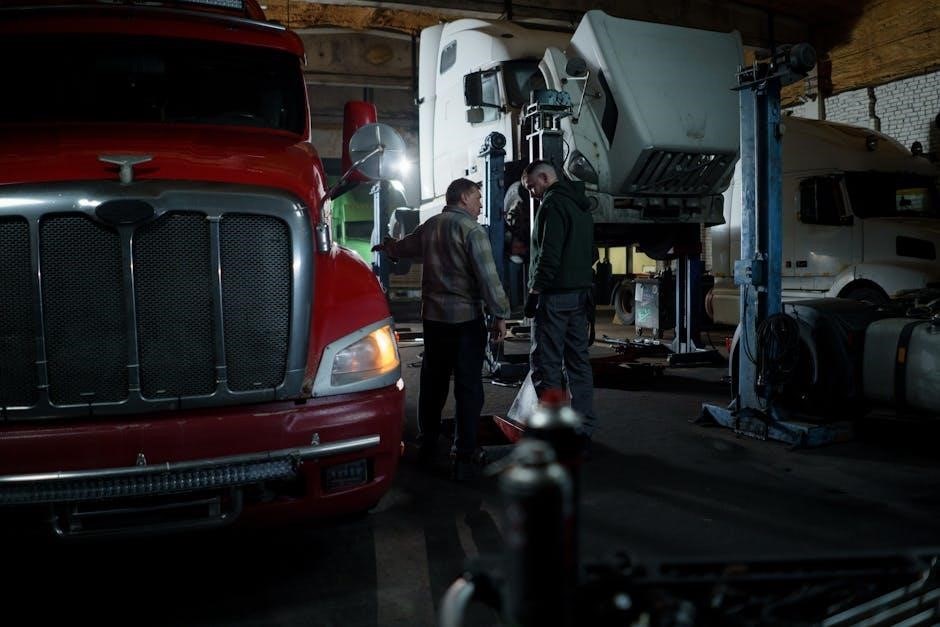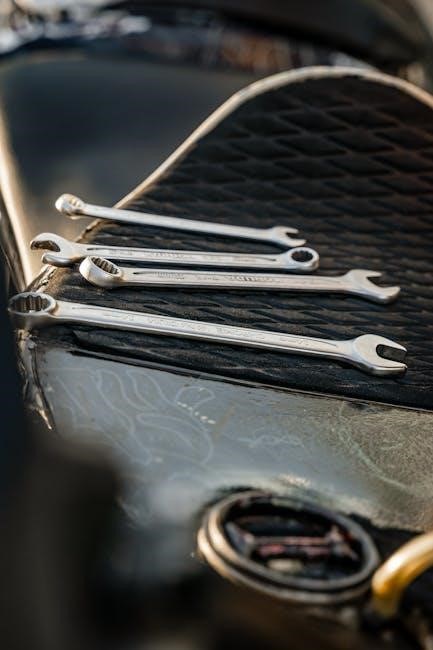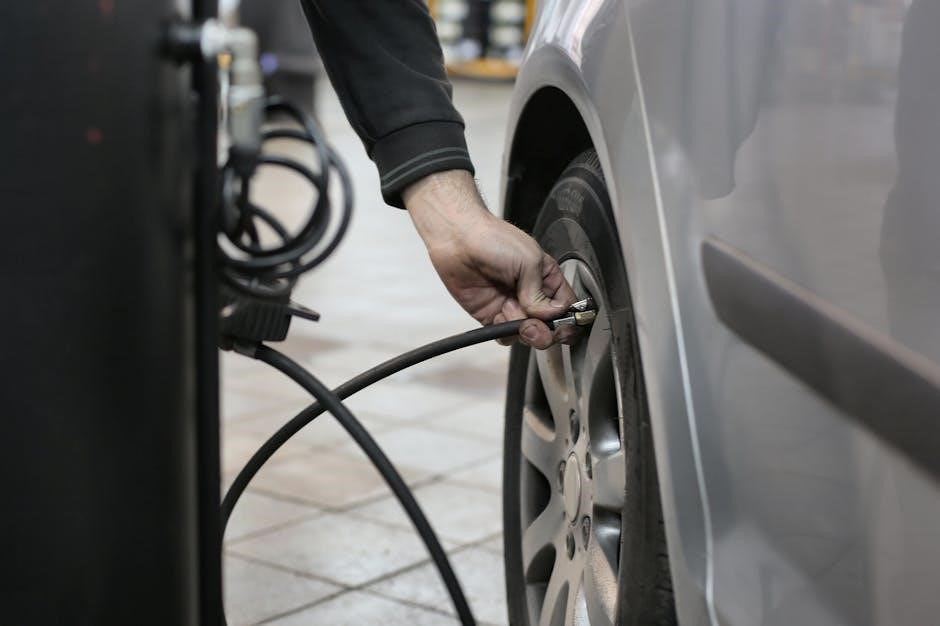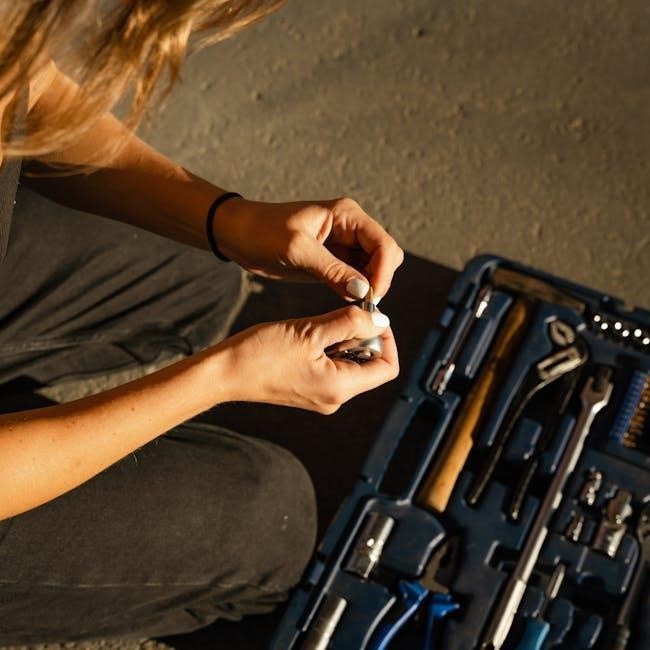Welcome to the ultimate guide on RV repair and maintenance manuals! These manuals are essential for ensuring your recreational vehicle runs smoothly, safely, and efficiently. They provide detailed instructions for troubleshooting, repairing, and maintaining various systems and components of your RV. Whether you’re a seasoned RV owner or a newcomer, having the right manual can make all the difference in extending the lifespan of your vehicle and preventing costly breakdowns. This guide will walk you through everything you need to know about RV repair and maintenance manuals, helping you keep your home on wheels in top condition.
1.1 What is an RV Repair and Maintenance Manual?
An RV repair and maintenance manual is a comprehensive guide designed to help owners and technicians diagnose, repair, and maintain recreational vehicles. It covers various systems, including electrical, plumbing, and mechanical components. The manual typically includes step-by-step instructions, troubleshooting tips, and safety guidelines. Available in formats like PDF, these manuals are essential for extending the lifespan of your RV and ensuring optimal performance. They provide detailed insights for both routine maintenance and complex repairs, making them indispensable for RV enthusiasts.
1.2 Importance of Using a Manual for RV Maintenance
Using an RV repair and maintenance manual is crucial for ensuring your vehicle operates safely and efficiently. It provides step-by-step guidance for troubleshooting and fixing issues, saving time and money. The manual helps prevent breakdowns by outlining regular maintenance tasks and safety protocols. By following the manual, you can extend the lifespan of your RV and avoid costly repairs. It also empowers owners to handle routine maintenance and repairs confidently, ensuring optimal performance and reliability on the road.
Where to Find RV Repair and Maintenance Manuals
RV repair and maintenance manuals can be found on official manufacturer websites, third-party PDF platforms, and specialty RV forums. These resources offer free or paid downloads, ensuring easy access to essential guides for your RV.
2.1 Official Manufacturer Websites
Official manufacturer websites are a reliable source for RV repair and maintenance manuals. Many brands offer free PDF downloads for their specific models, ensuring authenticity and relevance. These manuals typically include detailed instructions for operation, maintenance, and repairs, tailored to the particular make and year of your RV. They are often organized by model and year, making it easy to find the exact guide you need; Visiting the official website of your RV’s manufacturer is a great starting point for accessing genuine manuals.
2.2 Third-Party PDF Platforms
Third-party PDF platforms offer a wide range of RV repair and maintenance manuals for free or paid download. Websites like PDFDrive and others provide access to manuals for various RV models and components. These platforms often aggregate manuals from multiple manufacturers, making it easier to find specific guides. While convenient, ensure the manuals are up-to-date and relevant to your RV’s make and model. Be cautious of outdated versions and always verify the source for accuracy and reliability.
2.3 Specialty RV Repair Forums and Communities
Specialty RV repair forums and communities are invaluable resources for finding repair and maintenance manuals. These platforms, often moderated by experienced RV owners or technicians, offer a wealth of knowledge and shared resources. Members frequently post and exchange PDF manuals, repair guides, and troubleshooting tips. Many communities also provide expert advice and support for specific RV models or systems. Engaging with these forums can help you access rare or hard-to-find manuals while connecting with a network of like-minded enthusiasts.

Key Components of an RV Repair Manual
An RV repair manual typically includes diagnostic guides, step-by-step repair procedures, and maintenance schedules. These components help users identify issues, perform fixes, and keep their RV in optimal condition.
3.1 Diagnostic Troubleshooting Guides
Diagnostic troubleshooting guides are essential for identifying and resolving issues in your RV. These sections provide detailed symptoms, potential causes, and step-by-step solutions for common problems. Whether it’s an electrical malfunction, a plumbing leak, or an appliance failure, these guides help you pinpoint the root cause. By following the instructions, you can address issues early, preventing minor problems from escalating into costly repairs. This section is a cornerstone of effective RV maintenance, ensuring your vehicle remains functional and safe on the road.
3.2 Step-by-Step Repair Procedures
Step-by-step repair procedures in RV manuals provide clear, detailed instructions for fixing various components. From electrical systems to plumbing and appliances, these guides walk you through each repair process. They often include lists of required tools, materials, and safety precautions. By following these procedures, you can address issues confidently, ensuring repairs are done correctly. This section is invaluable for DIY enthusiasts and professionals alike, helping to restore your RV to optimal condition efficiently and safely.
3.4 Maintenance Schedules and Checklists
Maintenance schedules and checklists in RV manuals outline routine tasks to ensure your vehicle remains in peak condition. These include monthly inspections of critical systems like brakes and electrical components, as well as annual servicing for appliances and plumbing. Checklists provide a structured approach to tracking maintenance activities, helping you stay organized and proactive. By following these schedules, you can prevent potential issues, reduce repair costs, and extend the lifespan of your RV.

Preventive Maintenance Tips from Manuals
Manuals emphasize regular inspections of critical systems, fluid and filter replacements, and tire checks to prevent breakdowns. These tips help maintain performance, safety, and longevity of your RV.
4.1 Regular Inspection of Critical Systems
Regular inspections of critical systems are vital for preventing issues. Manuals recommend checking electrical, plumbing, and propane systems, as well as tires and brakes, to ensure safety and functionality. Routine checks help identify potential problems early, avoiding costly repairs. Pay attention to signs of wear, leaks, or damage. Follow the manual’s inspection schedule and checklist to maintain your RV’s performance and extend its lifespan. Neglecting these steps can lead to breakdowns and compromise safety on the road.
4.2 Fluid and Filter Replacement Guidelines
Regular fluid and filter replacements are crucial for maintaining your RV’s performance and longevity. Manuals outline specific schedules for engine oil, coolant, and transmission fluid changes. Air and fuel filters should be replaced as recommended to ensure proper engine function and fuel efficiency. Neglecting these tasks can lead to premature wear, reduced performance, and potential system damage. Always use the correct fluids and filters specified in your manual to maintain optimal conditions and avoid costly repairs down the road;
4.3 Tire and Brake Maintenance Recommendations
Proper tire and brake maintenance is vital for safety and performance. Manuals recommend checking tire pressure regularly, inspecting tread depth, and ensuring even wear. Brake systems should be inspected for worn pads, fluid levels, and rotor condition. Replace brake components as specified to avoid failure. Lubricate wheel bearings annually and ensure proper brake alignment. Regular tire rotations and balancing can enhance stability and extend tire life. Follow the manual’s guidelines to maintain optimal braking and tire performance for a safe and smooth journey.
Troubleshooting Common RV Issues
Identify and resolve common RV problems like electrical malfunctions, plumbing leaks, and heating failures. Manuals provide diagnostic guides to help you pinpoint issues and implement quick fixes effectively.
5.1 Electrical System Malfunctions
Electrical issues are common in RVs, often caused by faulty wiring, blown fuses, or malfunctioning circuit breakers. Manuals offer troubleshooting steps to identify and repair electrical system problems. They provide guidance on testing voltage, checking connections, and replacing faulty components. With detailed diagrams and step-by-step instructions, you can address issues like flickering lights or non-functional appliances. Regular inspection of electrical systems, as outlined in manuals, helps prevent hazards and ensures reliable power supply during your trips.
5.2 Plumbing and Water System Leaks
Plumbing leaks in RVs can lead to water damage and mold growth, making prompt repair essential. Manuals guide you in identifying leaks by checking connections, hoses, and seals. They often recommend inspecting water pumps, pipes, and fittings for cracks or corrosion. Regularly testing water pressure and winterizing the system can prevent issues. Always consult your manual for specific repair steps to ensure leaks are fixed correctly and efficiently, avoiding further damage to your RV’s interior and systems.
5.3 Heating and Cooling System Failures
Heating and cooling system failures in RVs can disrupt comfort during trips. Manuals often highlight issues like faulty thermostats, refrigerant leaks, or clogged vents. Regular inspections of ducts, filters, and compressors are crucial. Diagnosing problems early prevents system shutdowns. Always refer to your manual for specific repair steps, ensuring proper function and efficiency. Addressing these issues promptly helps maintain a comfortable environment and prevents further damage to your RV’s climate control systems.

DIY Repair Guidance in Manuals
DIY repair guidance in manuals provides step-by-step procedures, troubleshooting tips, and safety precautions for RV owners to perform repairs confidently and effectively. Manuals ensure proper techniques are followed.
6.1 Tools and Equipment Required
RV repair manuals outline the essential tools and equipment needed for DIY maintenance and repairs. Common tools include wrenches, screwdrivers, pliers, and multimeters for electrical work. Specialized equipment like torque wrenches and hydraulic presses may be required for specific tasks. Safety gear such as gloves and goggles is also emphasized to ensure protection during repairs. The manual provides detailed lists to help owners prepare and stay organized, ensuring they have everything needed before starting a project.
6.2 Safety Precautions for DIY Repairs
RV repair manuals strongly emphasize safety precautions to ensure DIY repairs are performed securely. Always disconnect power sources and turn off gas before starting work. Wear protective gear like gloves and safety glasses to prevent injuries. Proper ventilation is crucial, especially when handling chemicals or welding. Follow manufacturer guidelines for safe operating procedures. Never bypass safety protocols, as this can lead to accidents or further damage. Prioritize your well-being and the integrity of your RV by adhering to these essential precautions.
6.3 Common DIY Repair Mistakes to Avoid
When tackling RV repairs, avoid common DIY mistakes that could lead to costly damage or safety risks. Ignoring manufacturer guidelines is a frequent error, as it may result in improper repairs. Using incorrect replacement parts is another oversight, which can compromise functionality and safety. Additionally, rushing through repairs without following step-by-step instructions can lead to overlooked critical steps. Always double-check your work and consult a professional if unsure. These mistakes can be avoided by carefully following the manual and taking the time to ensure each repair is done correctly.

Understanding RV Appliances and Systems
RV appliances and systems, such as electrical, plumbing, and HVAC, require regular maintenance to ensure optimal performance and comfort. Understanding these systems helps prevent breakdowns and ensures smooth operation.
7.1 Refrigerator and Freezer Maintenance
Regular maintenance of your RV’s refrigerator and freezer is crucial for optimal performance and food safety. Check seals for tightness, clean evaporator coils, and ensure proper ventilation. Defrost the freezer regularly to prevent ice buildup. Monitor temperature settings to maintain safe levels (below 40°F for refrigerators and 0°F for freezers). Inspect drain lines to avoid blockages and clean filters to improve efficiency. Follow the manual’s guidelines for specific models to extend appliance lifespan and prevent malfunctions during trips.
7.2 Oven and Stove Repair Tips
Regularly inspect your RV’s oven and stove for proper function and safety. Check igniter operation, burner jets, and electrical connections. Clean burner holes and igniter tips to ensure consistent flame production. Replace worn-out gaskets to prevent gas leaks and heat loss. For electronic ignition issues, consult your manual for specific troubleshooting steps. Always turn off the gas supply before performing repairs. Proper maintenance ensures efficient cooking and prevents potential hazards during your travels.
7.3 Bathroom and Sanitation System Care
Proper maintenance of your RV’s bathroom and sanitation system is crucial for hygiene and functionality. Regularly inspect seals and gaskets to prevent leaks. Clean the toilet, sink, and shower thoroughly, using appropriate cleaners to avoid damage. Check water levels in the holding tanks and ensure proper ventilation to prevent odors. Follow manual guidelines for waste disposal and system flushing. Address any issues promptly to maintain a safe and comfortable bathroom environment during your travels.

Exterior and Interior Maintenance
Regular cleaning and inspections are vital for maintaining your RV’s exterior and interior. Protect paint with wax, clean upholstery with approved products, and ensure window and door seals are tight. Inspect surfaces for damage and address repairs promptly to prevent deterioration. Proper care extends longevity and keeps your RV looking its best while ensuring a safe and comfortable living space during travels.
8.1 Paint and Bodywork Protection
Protecting your RV’s paint and bodywork is essential to maintain its appearance and value. Regular washing with mild detergents and waxing can prevent fading and damage from UV exposure. Avoid using harsh chemicals or abrasive materials that might scratch the surface. Inspect for chips or scratches and touch them up promptly to prevent rust. Use protective covers or UV-resistant products for prolonged sun exposure. Addressing minor damage early ensures your RV remains in pristine condition for years of enjoyment on the road.
8.2 Upholstery and Carpet Cleaning Tips
Regular cleaning of your RV’s upholstery and carpets is crucial for maintaining a fresh and comfortable interior. Vacuum fabrics and carpets thoroughly, and spot clean stains immediately using mild detergents. Avoid harsh chemicals that may damage materials. For tougher stains, consider using fabric-specific cleaners or steam cleaning. Always test a small area first. Protect upholstery with fabric guard sprays to repel spills and stains. Deep clean carpets annually to remove embedded dirt and allergens, ensuring your RV stays clean and hygienic for years to come.
8.3 Window and Door Sealing Techniques
Proper window and door sealing is essential to prevent air leaks, moisture damage, and energy loss in your RV. Inspect seals regularly for cracks or wear. Clean surfaces before applying new weatherstripping or silicone-based sealants. Ensure doors and windows align properly for a tight fit. Use manufacturer-recommended products to maintain durability. Reapply sealants annually or after extreme weather conditions to keep your RV dry and energy-efficient. Regular maintenance will help preserve the integrity of your RV’s interior and exterior.

Advanced Repair Techniques
Advanced RV repair involves specialized methods like welding, fabrication, and complex system diagnostics. These techniques require precision tools and expertise to ensure durability and safety. Mastering them enhances your RV’s performance and longevity, addressing issues beyond basic maintenance. Detailed guides in manuals provide step-by-step instructions for tackling intricate repairs, helping you restore your RV to optimal condition efficiently.
9.1 Welding and Fabrication for RV Repairs
Welding and fabrication are critical skills for advanced RV repairs, often required for metalwork and structural fixes. Manuals provide detailed guidance on techniques like MIG welding for repairing metal frames or patching holes. Fabrication involves creating custom parts, such as brackets or panels, ensuring a precise fit. Proper safety gear and tools are essential, as outlined in repair guides. These methods help restore your RV’s integrity, preventing further damage and ensuring long-term durability. Always follow manual instructions to achieve professional-grade results.
- Metal patching and frame reinforcement.
- Custom fabrication for unique RV components.
- Essential safety precautions and tools.
9.2 Advanced Electrical System Diagnostics
Advanced electrical system diagnostics are crucial for identifying and resolving complex issues in your RV’s wiring, circuits, and components. Manuals provide step-by-step troubleshooting guides, helping you locate faults efficiently. Tools like multimeters and circuit testers are essential for diagnosing problems such as short circuits, faulty fuses, or malfunctioning sensors. By following the manual’s guidance, you can repair electrical systems safely and effectively, ensuring your RV’s lights, appliances, and electronics function properly. Regular diagnostics prevent unexpected breakdowns and enhance overall performance.
- Troubleshooting wiring and circuit issues.
- Using specialized tools for accurate diagnostics.
- Repairing faulty electrical components.
9.3 Plumbing System Overhauls
A plumbing system overhaul involves a comprehensive inspection and repair of your RV’s water and waste systems. Manuals guide you through replacing worn-out seals, checking for leaks, and cleaning corroded pipes. Regularly inspecting water pumps, valves, and fittings ensures optimal water flow and prevents contamination. Addressing issues early prevents major damage and keeps your RV’s plumbing system functioning reliably. Always follow manual instructions for safe and effective overhauls.
- Inspecting tanks, pipes, and fittings for damage.
- Replacing faulty water pumps and valves.
- Addressing leaks and corrosion promptly.

Safety Guidelines for RV Maintenance
RV maintenance requires strict safety measures to prevent accidents. Always ensure systems are off, use jack stands, and check for gas leaks. Keep a first aid kit handy for emergencies.
- Ensure all systems are turned off before starting repairs.
- Use jack stands for safe lifting.
- Check for gas leaks after propane maintenance.
- Keep a first aid kit nearby.
10.1 Proper Use of Safety Equipment
Using safety equipment correctly is crucial during RV maintenance to prevent injuries. Always wear gloves, goggles, and a respirator when handling chemicals or power tools. Ensure propane detectors and fire extinguishers are nearby. Use jack stands for secure lifting and test brakes after repairs. Keep emergency contact numbers accessible. Familiarize yourself with RV-specific safety gear like gas leak detectors and ventilation systems. Proper equipment usage ensures a safe working environment and protects against potential hazards.
- Gloves and goggles protect hands and eyes from harm.
- Respirators are essential for jobs involving chemicals or dust.
- Propane detectors alert you to dangerous gas leaks.
- Fire extinguishers must be easily accessible.
10.2 Hazardous Material Handling
Proper handling of hazardous materials is critical during RV maintenance to ensure safety and compliance with regulations. Always wear protective gear like gloves and goggles when dealing with chemicals. Store flammable liquids and gases in well-ventilated areas away from ignition sources. Dispose of hazardous waste according to local guidelines to prevent environmental contamination. Refer to your RV manual for specific instructions on handling propane, batteries, and other potentially dangerous materials. Improper handling can lead to accidents or legal consequences.
- Store flammable liquids in approved containers and ventilated spaces.
- Dispose of hazardous waste responsibly to avoid environmental harm.
- Follow manual guidelines for handling propane and batteries.
10.3 Fire Safety and Prevention Tips
Fire safety is crucial for RV owners to prevent accidents and protect their vehicle. Always inspect propane lines for leaks, ensure proper ventilation, and keep flammable materials away from heat sources. Install smoke detectors and a fire extinguisher, and familiarize yourself with their operation. Regularly check electrical systems for faults and avoid overloading circuits. Store flammable liquids in approved containers and maintain a fire evacuation plan. Adhere to these guidelines to minimize fire risks and ensure a safe journey.
- Inspect propane lines for leaks and damage.
- Install smoke detectors and ensure they are functional.
- Keep flammable materials away from heat sources.

Resources for Further Learning
Explore extensive resources for RV repair and maintenance, including downloadable PDF manuals, online courses, and video tutorials. These tools offer comprehensive guides for DIY repairs and troubleshooting.
11.1 Recommended Repair Manual PDFs
Discover a wide range of free and downloadable RV repair manual PDFs, offering detailed guides for troubleshooting and maintaining your vehicle. Popular options include the Trailer Life RV Repair and Maintenance Manual, which covers essential DIY fixes, and specific manufacturer manuals like the Fleetwood RV Owners Manual or Country Coach Service Manual. These resources provide step-by-step instructions, diagrams, and maintenance schedules to help you tackle repairs confidently. Visit official manufacturer websites or trusted forums to access these valuable resources tailored to your RV model.
11.2 Online Courses for RV Maintenance
Enhance your RV maintenance skills with online courses designed to guide you through essential repairs and upkeep. Platforms like Udemy and Coursera offer courses tailored for RV owners, covering topics such as DIY repairs, electrical system diagnostics, and plumbing maintenance. These courses often include video tutorials, hands-on exercises, and expert tips to ensure you gain practical knowledge. Whether you’re a beginner or an experienced RV enthusiast, these resources provide comprehensive training to keep your vehicle in optimal condition and prevent costly breakdowns.
11.3 RV Repair Video Tutorials
RV repair video tutorials are an excellent resource for visual learners, offering step-by-step guidance on various maintenance and repair tasks. Platforms like YouTube and specialized RV websites host a wide range of tutorials, covering topics from plumbing fixes to electrical system diagnostics. These videos often feature experienced technicians demonstrating techniques, making complex tasks easier to understand. Many tutorials also include tips for troubleshooting common issues and performing routine maintenance, helping RV owners gain confidence in handling repairs independently. They are accessible online, providing convenient learning opportunities for all skill levels.

Common Mistakes to Avoid in RV Repair
Common mistakes include ignoring manufacturer guidelines, skipping safety protocols, and using incorrect parts, which can lead to further damage and safety risks. Always follow manual instructions carefully;
12.1 Ignoring Manufacturer Guidelines
Ignoring manufacturer guidelines is a critical mistake that can void warranties, lead to unsafe repairs, and cause further damage to your RV. Always adhere to the instructions provided in your RV repair and maintenance manual, as they are tailored to your specific vehicle. Deviating from these guidelines can result in improper repairs, safety hazards, and costly rework. Ensure all maintenance and repairs align with the manufacturer’s recommendations to maintain your RV’s performance, safety, and longevity. Proper adherence guarantees reliability and avoids potential risks.
12.2 Skipping Safety Protocols
Safety protocols are non-negotiable in RV repair and maintenance. Skipping them can lead to injuries, fires, or further damage to your vehicle. Always follow the safety guidelines outlined in your RV repair manual, such as disconnecting power sources, wearing protective gear, and ensuring proper ventilation. Neglecting these steps can result in serious consequences. Prioritize your safety and the integrity of your RV by adhering to all recommended precautions. A moment of negligence can have long-lasting repercussions, so stay vigilant and proactive in maintaining a safe working environment.
12.3 Using Incorrect Replacement Parts
Using incorrect replacement parts is a common mistake that can lead to safety hazards and further damage to your RV. Always refer to your RV repair manual for specific part numbers and specifications. Substituting with generic or incompatible parts can void warranties, compromise performance, and even lead to system failures. Ensure all replacements are manufacturer-approved and suitable for your RV model. This prevents potential risks and ensures reliability. Consulting authorized dealers or professionals is highly recommended to avoid such errors.
13.1 Summary of Key Takeaways
RV repair and maintenance manuals are indispensable tools for ensuring your vehicle runs efficiently and safely. They provide detailed troubleshooting guides, maintenance schedules, and repair procedures to prevent breakdowns and extend your RV’s lifespan. Regular inspections, fluid replacements, and adherence to safety protocols are crucial. DIY repairs can save costs but require caution and proper tools. Always consult manufacturer guidelines to avoid mistakes and ensure reliability. By following these practices, you can enjoy a stress-free and enjoyable RV experience for years to come.
13.2 Encouragement for Regular Maintenance
Regular maintenance is key to preserving your RV’s performance and longevity. By following the guidelines in your RV repair and maintenance manual, you can identify and address issues before they escalate. Consistent checks on systems like tires, brakes, and plumbing ensure safety and reliability. A well-maintained RV not only avoids costly repairs but also enhances your travel experiences. Stay proactive, follow the manual’s schedules, and enjoy a worry-free journey with your home on wheels.
